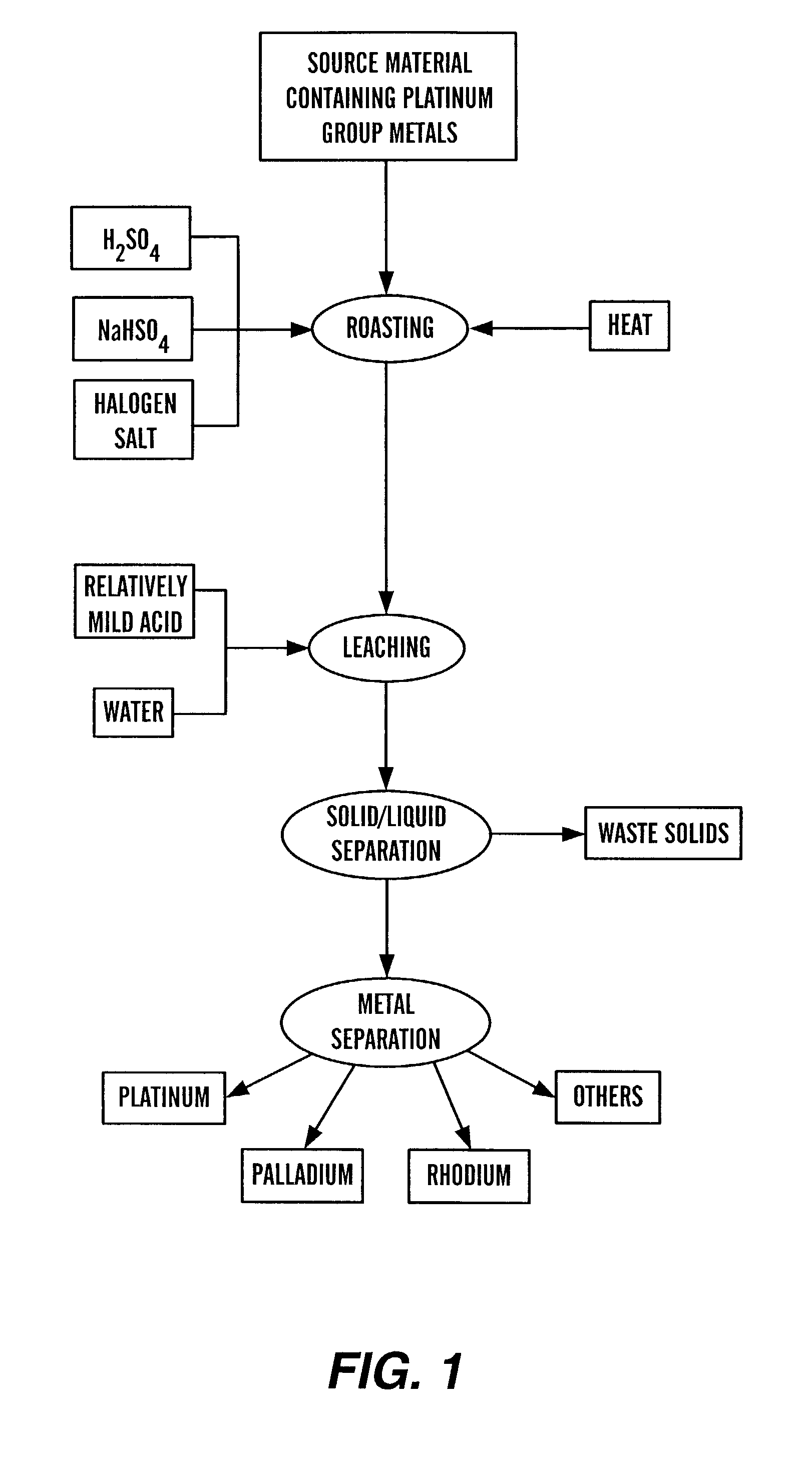Recovery of platinum group metals
- Summary
- Abstract
- Description
- Claims
- Application Information
AI Technical Summary
Benefits of technology
Problems solved by technology
Method used
Image
Examples
example 1
[0028]In this example, the following quantities of the following ingredients were added to form a roasted mixture. This experiment represents a typical test of many similar experiments performed.
[0029]
ItemIngredientQuantityA.honeycomb type auto catalysts100 gramsB.concentrated H2SO4 10 mlC.sodium chloride, NaCl 10 gramsD.water 10 grams
[0030]Item A was a ground material passing through a US standard screen of 20 mesh from spent automobile catalytic converters and consisted of 800 ppm of platinum, 260 ppm of palladium and 195 ppm of rhodium imbedded in an alumina-silicate matrix of honeycomb structure.
[0031]The above mixture was subjected to drying in an oven at 100° C. for 30 min. The dried product was then subjected to roasting at 1000° F. (538° C.) for 30 min. The roasted product was then subjected to dissolution in a 500 ml halogen salts solution (100 grams of NH4Br, 2.5 grams NH4I, 25 ml of H2SO4, 0.5 grams of 12; all of these chemicals in 850 grams of water) at 85° C. for 30 min...
example 2
[0035]In this example, the following quantities of the following ingredients were added to form a roasted mixture. This experiment represents a typical test of many similar experiments performed.
[0036]
ItemIngredientQuantityA.honeycomb type auto catalysts100 gramsB.concentrated H2SO4 10 mlC.sodium chloride, NaCl 10 gramsD.water 10 grams
[0037]Item A was a ground material passing through a US standard screen of 20 mesh from spent automobile catalytic converters and consisted of 800 ppm of platinum, 260 ppm of palladium and 195 ppm of rhodium imbedded in an alumina-silicate matrix of honeycomb structure.
[0038]The above mixture was subjected to drying in an oven at 100° C. for 30 min. The dried product was then subjected to roasting at 1000° F. (538° C.) for 30 min. The roasted product was then subjected to dissolution in a 500 ml HCl and HNO3 solution (20 ml concentrated HCl and 20 ml concentrated HNO3 in 460 ml of water) at 85° C. for 30 min. After 1 hour dissolution reaction, the solu...
example 3
[0042]In this example, the following quantities of the following ingredients were added to form a roasted mixture. This experiment represents a typical test of many similar experiments performed.
[0043]
ItemIngredientQuantityA.honeycomb type auto catalysts100 gramsB.sodium bi-sulfate 5 gramsC.concentrated H2SO4 5 mlD.water 10 grams
[0044]Item A was a ground material passing through a US standard screen of 60 mesh from spent automobile catalytic converters and consisted of 800 ppm of platinum, 260 ppm of palladium and 195 ppm of rhodium imbedded in an alumina-silicate matrix of honeycomb structure.
[0045]The above mixture was subjected to drying in an oven at 100° C. for 30 min. The dried product was then subjected to roasting at 1000° F. (538° C.) for 30 min. The roasted product was then subjected to dissolution in a 500 ml halogen salts solution (100 grams of NH4Br, 2.5 grams NH4I, 25 ml of H2SO4, 0.5 grams of I2; all of these chemicals in 850 grams of water) at 85° C. for 30 min. Afte...
PUM
| Property | Measurement | Unit |
|---|---|---|
| Temperature | aaaaa | aaaaa |
| Temperature | aaaaa | aaaaa |
| Temperature | aaaaa | aaaaa |
Abstract
Description
Claims
Application Information
 Login to View More
Login to View More - R&D
- Intellectual Property
- Life Sciences
- Materials
- Tech Scout
- Unparalleled Data Quality
- Higher Quality Content
- 60% Fewer Hallucinations
Browse by: Latest US Patents, China's latest patents, Technical Efficacy Thesaurus, Application Domain, Technology Topic, Popular Technical Reports.
© 2025 PatSnap. All rights reserved.Legal|Privacy policy|Modern Slavery Act Transparency Statement|Sitemap|About US| Contact US: help@patsnap.com

